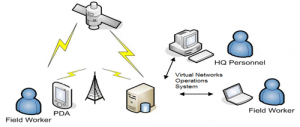Satellite-linked PDAs promise to speed Haitian relief effort

As Haitians dig furiously through the rubble to find survivors and the dead, Global Relief Technologies (GRT) is planning to map and record the destruction on the ground to give relief workers critical realtime information as they race against the clock.

The Portsmouth, N.H. company's Rapid Data Management System will be used to collect data on the ground with PDAs. A variety of media - texts, reports, photos, video and tweets - are transmitted via satellite to an Internet-based and secure Collaboration Center custom-designed for the client and its relief workers. Satellite communications are critical because land lines and cell towers are down in the ravaged areas.
With respect to Haiti, GRT is working with the Marines, National Guard, Red Cross and the USS Comfort floating hospital ship, which is heading to Haiti. Members in those units can securely access the Collaboration Center through any number of computing devices, PDAs and smartphones.
"They said to be standing by and be ready on short notice because everything is in flux right now. So what we've done so we are better prepared is get some satellite images of Port-au-Prince and the 100-kilometer region around there - the after picture if you will. We're comparing them with the before pictures we had from satellites and the fact we've already been done there doing schools assessments for USAID. So we have a lot of assessments from the area already done," said GRT senior vice president Adam Cote in a WBZ-Radio interview.
Just about any rescue or reconstruction information can be handled within the RDMS to answer questions such as. is a building intact, partially damaged or destroyed? What's it location? What does it look like before and after? Perhaps there are people still trapped inside. How many and for how long? What's known about their injuries? What's the local availability of resources? What are the detailed conditions of the roads, bridges and other infrastructure?
And emergency alerts can be broadcast to field workers as events dictate.
With the earthquake disaster and heartbreaking search for survivors dominating the news, local media outlets here in Boston with its sizable Haitian community have rushed to cover GRT. Its products have not been developed in a vacuum: several of the top executives including CEO and founder Michael Gray have spent extensive time in government or with the in the area of humanitarian aid.
Follow me on Twitter.
This post was originally published on Smartplanet.com